27 Parts of a Chair: Chair Anatomy Diagrammed
Author: Rick Worst | Editor: Omar Alonso
Review & Research: Jen Worst & Chris Miller
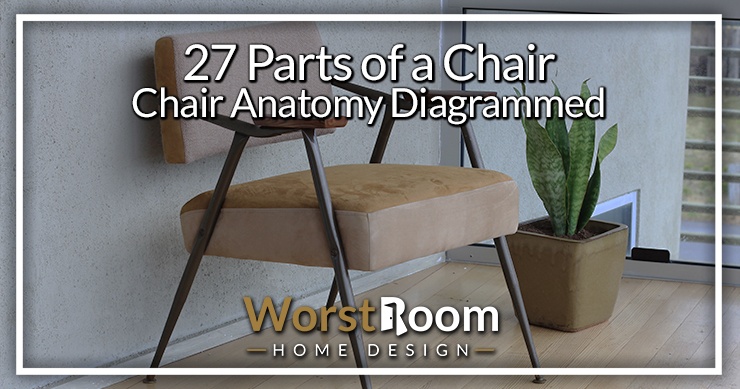
A chair is one of the most common pieces of furniture, and it's a staple in every house and office. The construction and design of different parts of a chair widely vary depending on their intended use. Your living room chair is more comfortable with thick cushioning as it is meant for relaxing.
On the other hand, dining chairs are more portable with the most basic parts. A chair can be made of wood, metal, acrylic, stone, or other strong materials. No matter how different the materials and styles are, every chair has some basic parts.
So, if you want to understand the anatomy of a chair, going through this guide is a must. Here you'll know about the chair parts and their functions. We will also provide a detailed diagram for better understanding. So without further ado, let's dive in.
Chair Diagram
We've prepared the chair diagram below to help you quickly visually associate the names of chair parts with the actual pieces.
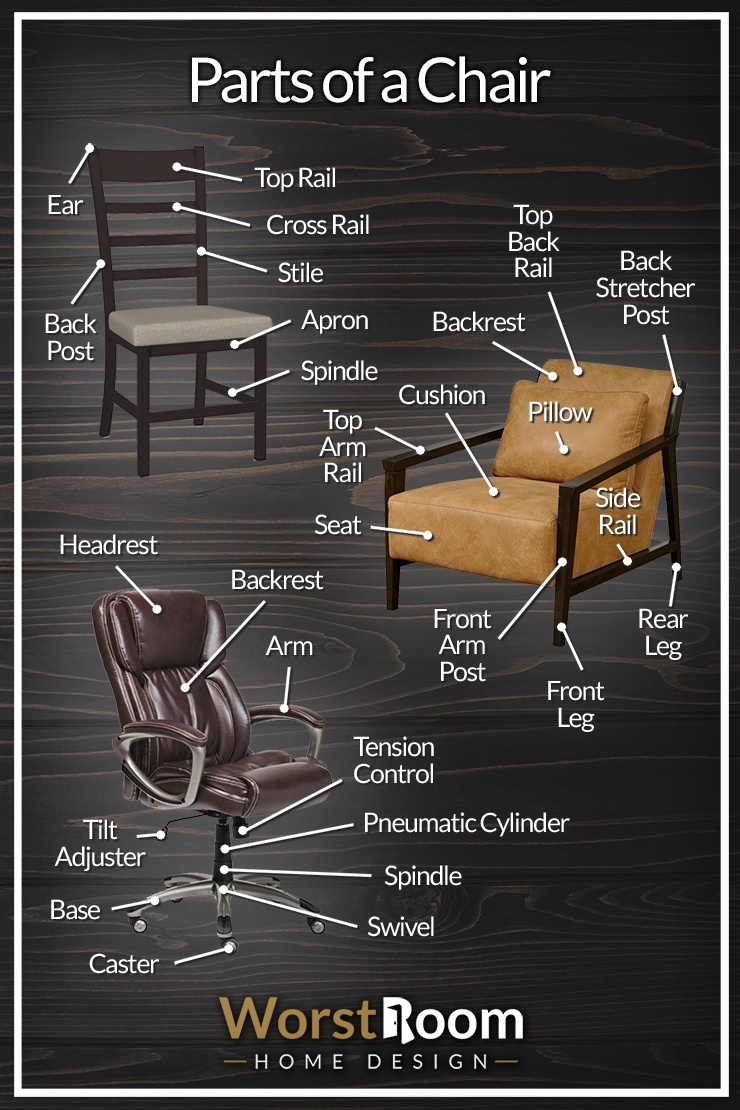
The chair part names can be unfamiliar at first, so studying this chair diagram a few times will help you eventually sort it out. This is important as a craftsman, who needs to be able to communicate with other woodworkers or furniture repairers effectively.
Parts of a Chair Explained - The Dining Chair
Let's start with the most basic one. Among all the different types of chairs, this one is the easiest to understand. Remember that some types of dining chairs might have extra parts to improve the style. However, the main parts of most dining chairs are the same, and these parts also feature in upholstered armchairs. These parts include…
Stile
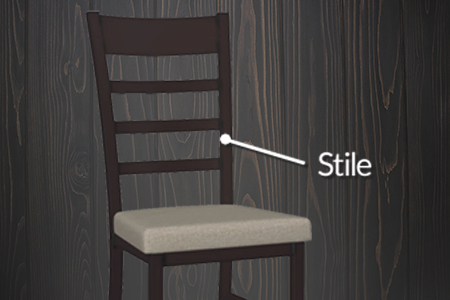
It's probably the most important part of a dining chair that make up the chair frame. Stile is the vertical part extending from the rear leg of the chair that supports its backrest. This is probably the longest vertical part of the frame of a dining chair.
Stile is attached to the top and cross rails on the side. It gives the chair stability and enough strength to carry the user's weight. Also, it supports your back while seated. A basic dining chair has a straight stile, while the fancier ones have a curved stile.
While buying your dining chair, make sure the stile is thick and made of strong materials so that it lasts for years.
Ear
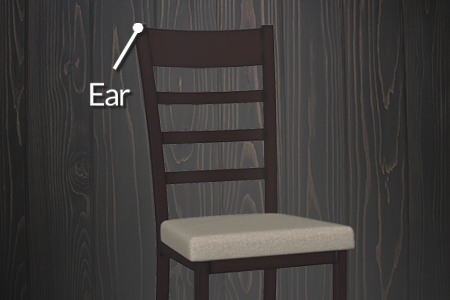
At the top of the stile, there's a short extension known as the ear. This wooden piece is very thick with defined edges. It is mostly curved, but straight ears are also common. This short part adds to the strength of the stile and is often used to create a distinct look.
Top Rail
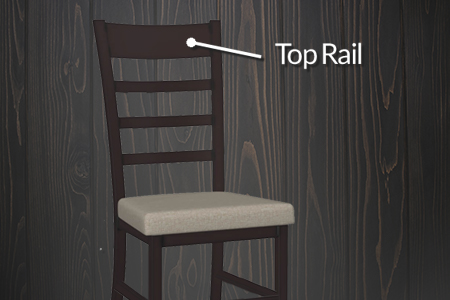
As the name implies, it's the topmost portion of a dining chair. The top rail runs horizontally, connecting the two vertical posts on the back of the chair. Apart from connecting the chair stiles, top rails provide sufficient support for the top part of a dining chair.
Top rails can be straight or curved with carvings or inlays for decoration. This part is essential to support the back of the user.
Cross Rail
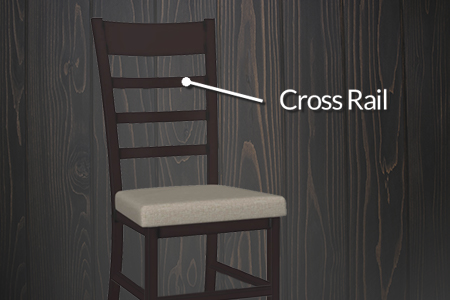
Another horizontally placed wooden piece running a few inches below the top rail is the cross rail. It also attaches the two stiles of a chair and provides support for the backrest. Similar to the top rail, this one is also an essential part of a chair that increases stability.
Some chairs have only one cross rail while some have more. It can also be used as a decorative part to enhance the look of the chair. Knowing the names of chair parts can help you appear impressive in conversation.
Back Post
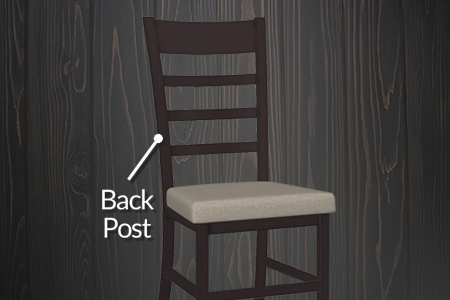
The back post is the other vertical piece of wood comprising the chair frame. It not only provides support for your back but also serves decorative purposes. Wood and metal are mostly used to construct the back post. Sometimes it's upholstered to improve its look and comfort. As far as parts of a chair go, the back post is probably the most defining design element.
You may wonder what differentiates the back post from the stile. You can think of them as two descriptors for the same structural piece. The stile will sometimes refer to the structure itself but also just the front face of it, while the back post can also refer to the whole structure or just the back face of it.
Seat
A seat of a chair is the part where we sit. It's probably the most important part as it holds the chair frame together. Usually, the seat is made of a strong material like wood. Metal and plastic seats are also used sometimes.
The seat may or may not be upholstered, depending on its uses. This is the part that provides the manufacturer more freedom to add various elements to the chair. It can be thickly cushioned and covered in various eye-catching colors.
Hence, you can choose from many different upholstery options as per your room decor, from the types of upholstery fabric, decorative rivets, thread colors, and much more.
Apron
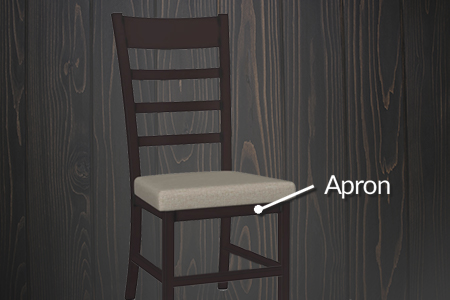
On the front of the chair, two horizontally running pieces tie the front and rear legs of the chair. These wooden pieces are called the apron, and you can rest your thighs on them while sitting on the chair. Sometimes people refer to them as skirts.
The front apron is made longer than the rear to provide more space for your legs. Also, the aprons are often covered with comfortable fabrics in some fancy chairs. They're not just decorative, either. They provide a lot of stability from racking by reinforcing the legs. They also hide braces and corner blocks from view.
Spindle
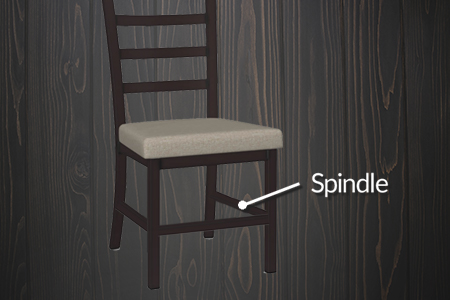
To improve the structural integrity of a dining chair, some additional pieces, named spindles, are used to tie the legs of the chair. Some chairs have spindles only on the back, while some have more for the front and sides.
The spindle is mostly made of the same material as the rest of the chair. However, since it's used to increase stability and support the legs, it can also be made of less sturdy materials like plastic.
Front & Rear Legs
The legs are undoubtedly the most important part of any chair, not only to support weight but in terms of decor. They carry the weight of the user and keep the frame stable. Both front and rear legs connect to the chair seat and extend up to the ground.
While the rear legs support the backrest, the front legs carry the seat. Chair legs often have intricate designs to increase their appeal. You must check out the legs carefully while buying dining chairs. The back legs are also built as one part of the stile, which adds even more rigid support.
Make sure these parts of a chair are made of durable and strong materials. Also, the attachment points should be completely secure. Only then should you concern yourself with the furniture leg styles that match your current decor.
The Parts of an Armchair
Without belaboring what we've already covered above, let me tell you about the parts of an armchair we haven't yet covered. Of all the types of chairs available, these are found in nearly every living room.
Backrest
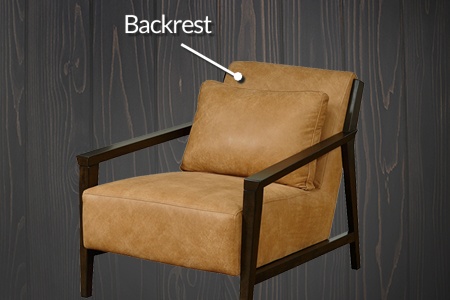
An armchair features an upholstered backrest that is comprised of many sub-parts. On an armchair a backrest will be much wider than a dining or office chair, and thus needs more support within the structure.
Top Back Rail
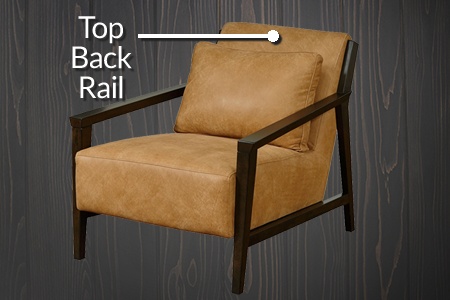
The frame of the backrest starts with back stretcher posts that are then tied together first with a top back rail. It stretches between the two back stretcher posts horizontally to support the users back and to stop the structure from racking and twisting.
Back Stretcher Posts
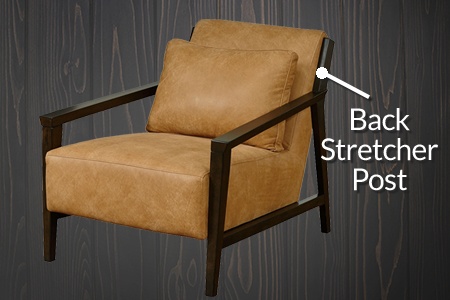
Like the stiles of a dining chair, the back stretcher posts are strong, vertical supports on the backside of the chair that run from the bottom side rail all the way up past the top arm rail to the top of the backrest.
Front Arm Posts
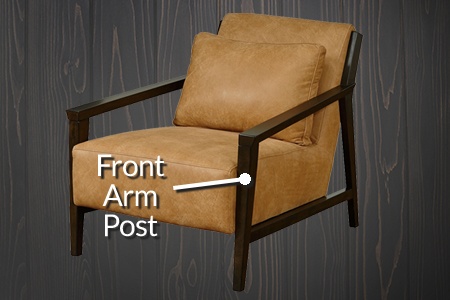
These posts serve the same function as the back posts, except they're on the front and not as tall. They will be connected to the back posts by side rails and to the each other with a front rail. They support much of the weight of the person sitting as well as keep the arm rests stable.
Side Rails
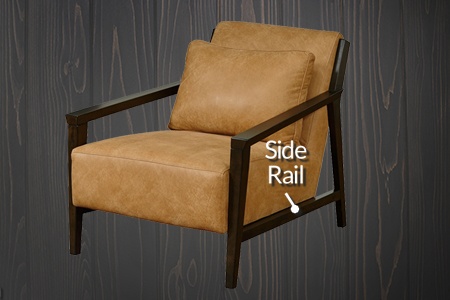
Side rails are connective boards that help stabilize the frame by connecting the front arm posts to the back stretcher posts. They exist at the bottom of the arm and along the top. One could argue the top arm rail is simply another side rail. They serve a similar function.
Front & Back Rails
The front, back, and side rails are very similar to an apron under a dining room chair seat, but they're a bit more structural. They do help resist racking, wobbling, twisting, and warping, but they also redistribute weight across all the load bearing posts.
Arm & Top Arm Rail
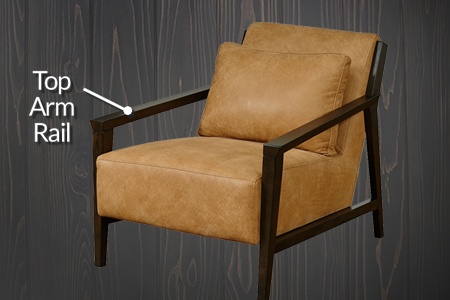
The arms are constructed from the frame of the front and back stretcher posts and the side rails, but there is often a more decoratively shaped top arm rail included. This rail is installed on the top and can help shape the arm and make it easier to do a complex upholstery job.
These parts of a chair are tempting to sit on, as most people end up doing, and that's a great way to ruin them. The cushioning becomes flat, the upholstery fabric becomes stretched, and the wood can even break.
Legs
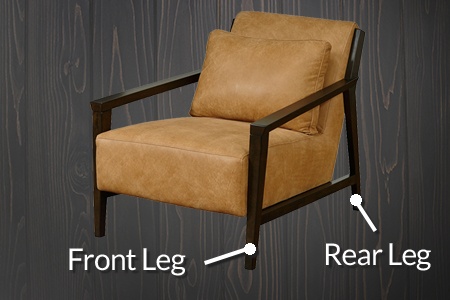
The legs can be a continuous part of the posts that form the four corners of the chair, or they can be separate pieces that are attached to the bottom of the frame once the entire chair is built and upholstered. Often they will screw in separately, as this make is easier to ship the furniture around.
Seat, Cushions, & Pillows
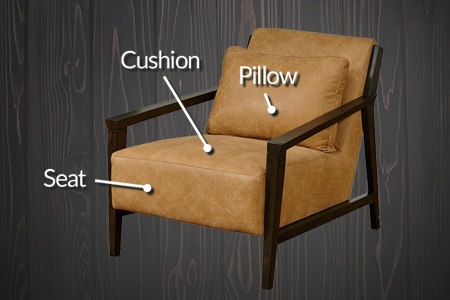
Armchairs are typically softer, featuring cushions or some kind of soft filler material within the seat, arms, and backrest, and will usually have decorative types of pillows added to bring in more color or offer more back support.
Anatomy of a Chair - The Office Chair
As you spend most of the time sitting on your office chair, it has more elements to keep you comfortable all day long. Here are the different parts of a typical office or desk chair…
Headrest
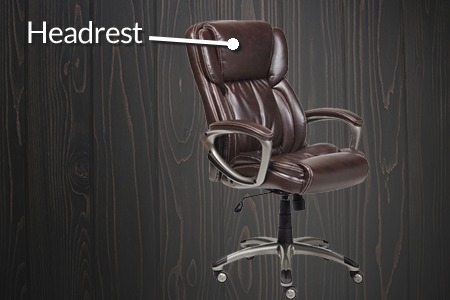
Starting from the top, the upper part that allows you to rest your head and neck is the headrest. It helps to reduce stress from your neck muscles and prevent neck pain. Many office chairs have separately adjustable headrests for better support.
Backrest
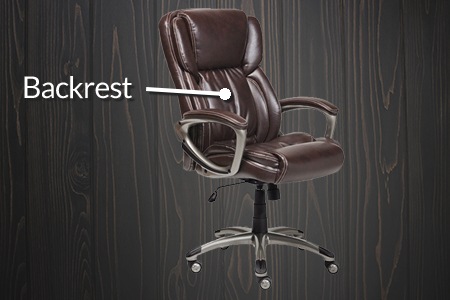
The tallest part of an office chair is where you rest your back. The backrest is very important to maintain a good posture while sitting. It's mostly made of wood and metal for stronger performance.
Mostly, the backrest of a chair is covered by comfortable fabrics and thickly cushioned to ensure maximum comfort. However, plastic-made mesh backrests are also very common.
Arms
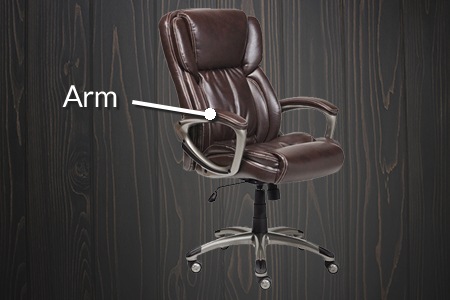
All office chairs come with two arms on each side to keep your arms and support your shoulders while seated. Some chairs have padded armrests for extra support and comfort. The armrests are mostly made of firm and supportive materials.
Nowadays, many expensive office chairs have adjustable armrests allowing the users to bring their arms closer to their bodies or place them further. Comfortable padding on the chair arms is necessary to maintain a good posture.
Seat
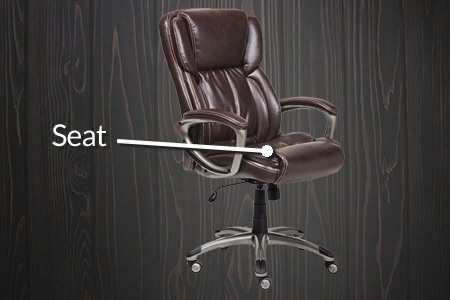
The chair seat is attached to the backrest, allowing the user to sit comfortably for long periods. Most office chairs have cushioned seats with high-quality fabric or leather seat covers.
Chair seats can be fixed or moveable. Also, some can be easily tailored according to the height of the user.
Tilt Adjuster & Tension Control
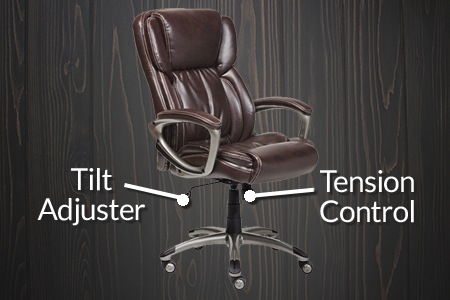
A tilt adjuster is placed on the seat bottom allowing the user to change the seat angle. It's a knob that can be easily turned to tilt the chair seat and adjust the user's posture.
Similarly, the tilt tension control is also placed beneath the seat in the form of a lever or knob. It helps you to adjust the tilt tension. Hence, you can decide the amount of difficulty you'll face while reclining the seat and back.
If the tilt tension is too low, the seat and backrest will feel very loose and move easily with the user. You shouldn't make it too tight either, as it will make tilting difficult. These parts of a chair let you customize your seating experience to your specific liking.
Pneumatic Cylinder
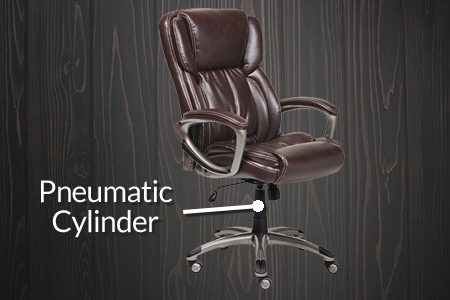
As mentioned, most office chairs' heights can be adjusted per the user's needs. The pneumatic cylinder allows you to change the position of the seat and move it upward or downward.
Spindle
Vertical rods that attach the cylinder to the base are called spindles. A spindle can be made of different materials, such as wood, plastic, or metal. It serves to elevate the height of the chair, in accordance to user's setting.
Swivel
At the chair base, a small metal or wooden part is located that allows the chair to rotate 360 degrees. This part is called a swivel, and you should definitely have an office chair that rotates for added convenience.
Base & Wheels (Casters)
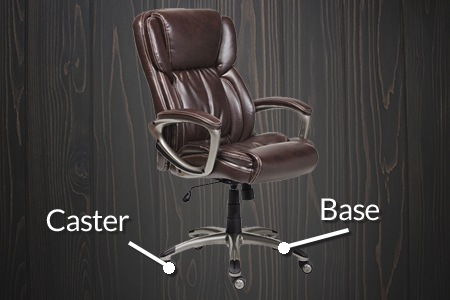
The most crucial part of an office chair is its base which holds the whole chair together. It keeps the chair stable and carries the user's weight. Just like a pedestal, the base has five arms, each ending on a caster.
Casters are another name for the wheels, which are usually two separate wheels contained in one assembly. Moreover, the chair wheels allow the chair to move easily on the floor. So, you can change your position without leaving your seat.
All the Parts of a Chair Easily Understood
When buying a chair, you should pay special attention to these parts as the stability and strength of the chair depends on their construction quality. Also, check out the upholstery, adjustability, height, and width of the seat to get the best chair that meets all your needs.
So, now you know all the parts of a chair and their function, thanks to the chair diagram above, and despite the differences; every chair shares some common parts like the seat, back, base, and legs. Learning the chair part names will help you when shopping or building your own chairs.



